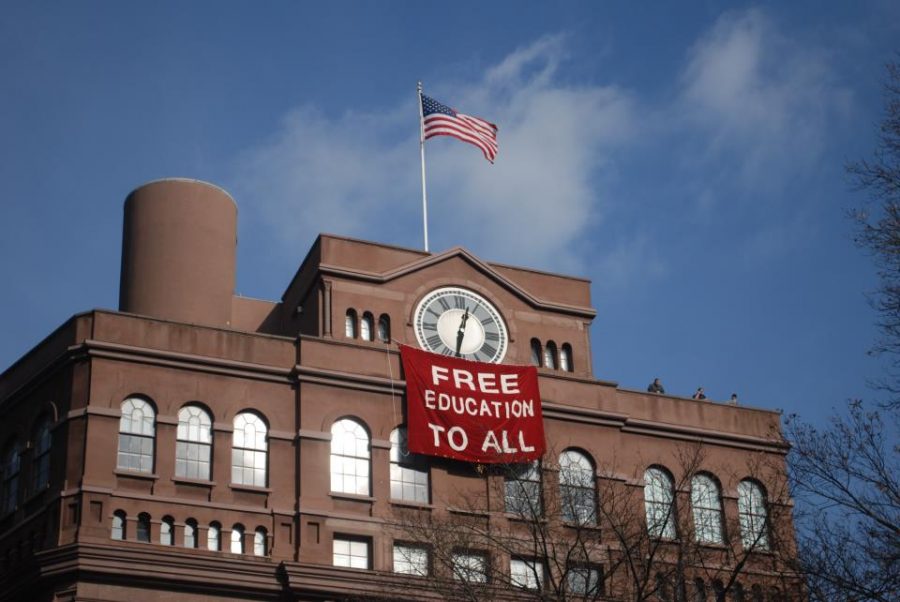Opinion: How ‘free college’ turned into a ‘state-by-state hodgepodge’
Students hang banner below the historic clock tower of the Cooper Union Foundation building in New York City during a december occupation in protest of the possibility of implementing tuition in the historically free school.
June 11, 2019
There’s a national conversation about “free” college taking place in statehouses and dining rooms across America. There are many students who want to attend college, but costs get in the way. Currently, only 47 percent of U.S. adults aged 24 to 64 have a college degree.
Michigan lags a bit further behind at 45 percent. By comparison, 57 percent of our neighbors in Canada and 51 percent of adults in Japan have a college degree, according to the National Center for Education Statistics. We must do better.
Many elected officials, especially at the state level, are responding to this call by focusing on community college degrees or credentials. Certainly, these are the easiest programs to make “free.”
A 21st century economy requires a robust variety of postsecondary options. We need people who can see connections across a variety of disciplines and who are trained to lead organizations through radically changing circumstances.
That skill-set is where private liberal arts institutions excel.
“Free” should not always be the only consideration because it often comes with strings attached, such as where students can attend and what they can study. Unfortunately, the myriad “free college” plans being presented are working against private institutions and against choice by locking students in to a single low-cost path. Many students arrive on campus having received little to no mentoring or guidance in what to expect from college.
Additional research from the National Center for Education Statistics provides evidence that the smaller, more specialized programs available at private institutions are often more successful at graduating and launching those who come from historically underserved backgrounds.
Free college has a nice ring to it, and generally people think they understand what you mean when you say “free.” That’s why it has become a staple of Democratic presidential candidates’ platforms.
There are more than 45 pieces of legislation in 19 states and the District of Columbia on free college, according to the Education Commission of the States. That is on top of the more than 350 local and state college programs throughout the country all proposing their own forms of “free college.”
But “free” doesn’t always mean free, and the fine print can have huge implications for students and their families.
Why are there so many “free college” programs? The short answer is that we are trying to solve a national issue with state-by-state policies. Poverty doesn’t adhere to state lines, though, so why would we create policies that have a major impact on the state of Michigan, where I live, yet Indiana or Ohio could have their own policies just a few miles south?
The answer to the state-by-state hodgepodge is to invest and fund a federal program that we already have: Pell. Born out of the Higher Education Act of 1965, Pell Grants give low-income students money to help pay for college and associated expenses. Students receive the grants based on demonstrated family need. The maximum award, however, is $6,095 per year. Even at in-state, public institutions in Michigan, this only covers roughly a quarter of the cost of attendance. This year, the federal government bumped up Pell monies by $100 — not quite the bold action required.
Imagine if we increased the maximum award to, say, $30,000 per year. What would this do?
First, it would give choices to families. Is a community college, a large public institution or a small, private college the best fit for you?
Secondly, it would improve graduation rates, I believe. When students find themselves with the support they need to grow, they flourish. Unfortunately, students are too often put in situations where they are set up to fail because of a lack of institutional resources.
Lastly, and perhaps most importantly, it would directly benefit low-income students, a claim that few policies can make.
The Institute for Higher Education Policy (IHEP) reports that “free college” programs in New York and Tennessee did nothing to make college more affordable for low-income students because they didn’t allocate sufficient “state funding to the students with the greatest need.” IHEP’s research concludes that these programs “do little to remove affordability barriers for low-income students, and instead allocate limited funding to middle- and, in the case of Tennessee, high-income students.”
An expansion and funding of Pell solves two problems. First, it eliminates the ability of politicians to gain political points by confusing their constituents. The Excelsior Scholarship in New York is touted as a “free college” program but it isn’t that simple. Students must meet a number of requirements to receive their “free” tuition, including GPA minimums, state residency requirements after graduation, and specific conditions for attending full-time and graduating on time. Yet, on-time graduation rates remain low, especially for low-income students.
An increasing focus on Pell would mean that we’ll equitably distribute dollars to the students and families most in need. We don’t need more programs that are funding college tuition for high-income families. Pell provides resources for low- and middle-income families, and those resources aren’t just limited to immediate education costs. Pell dollars can be used for childcare and living expenses, two of the biggest reasons that students feel pressure to drop out.
State-by-state programs serve a meaningful purpose, but we need a national solution like dramatically increased Pell funding. Such a solution is equitable and resistant to manipulation by those who would bend college financing policies to favor narrow political interests. Let’s do something right for students, not just fool them into thinking they’ve got “free college.”
If we believe that all students, regardless of their ability to pay, should have access to postsecondary education, then we must start funding it and stop talking.
This story on college access was produced by The Hechinger Report, a nonprofit, independent news organization focused on inequality and innovation in education. Sign up for our newsletter.
Jeff Abernathy is president of Alma College in Alma, Michigan.




















